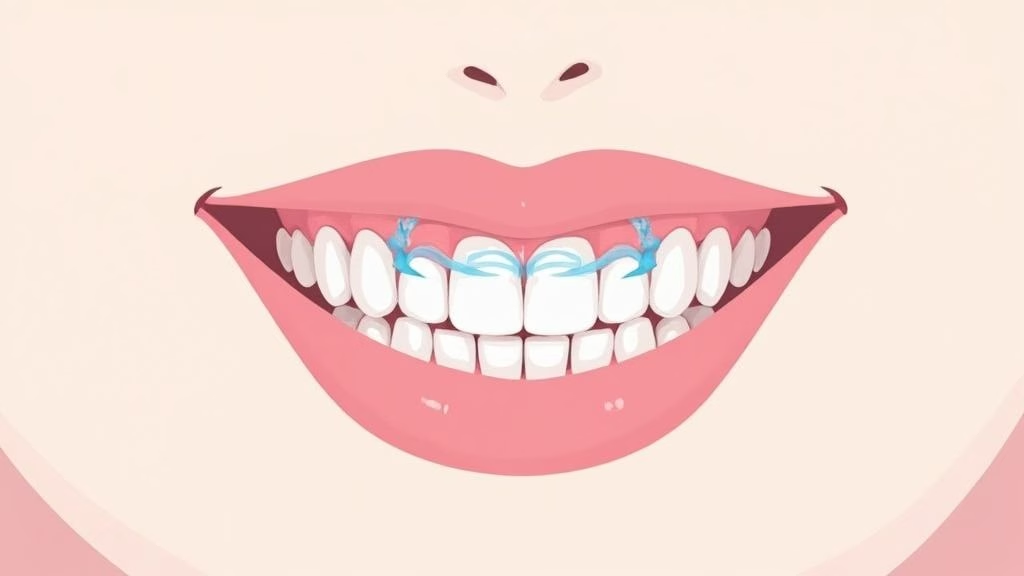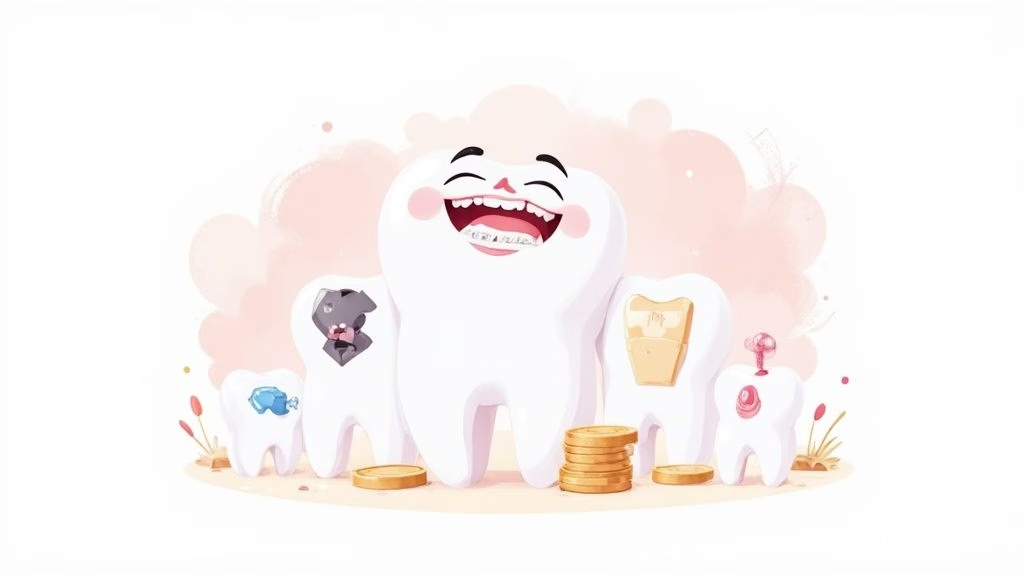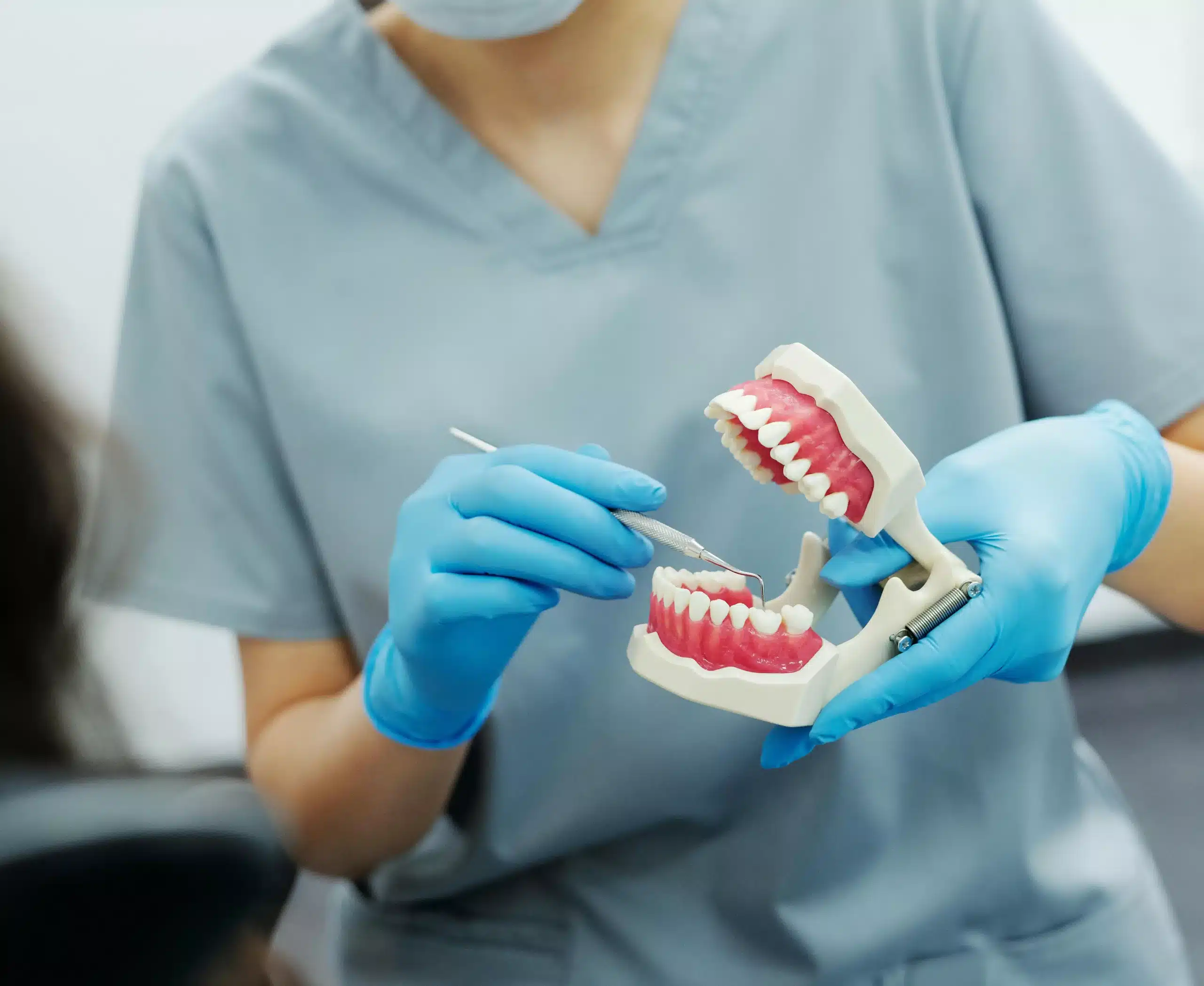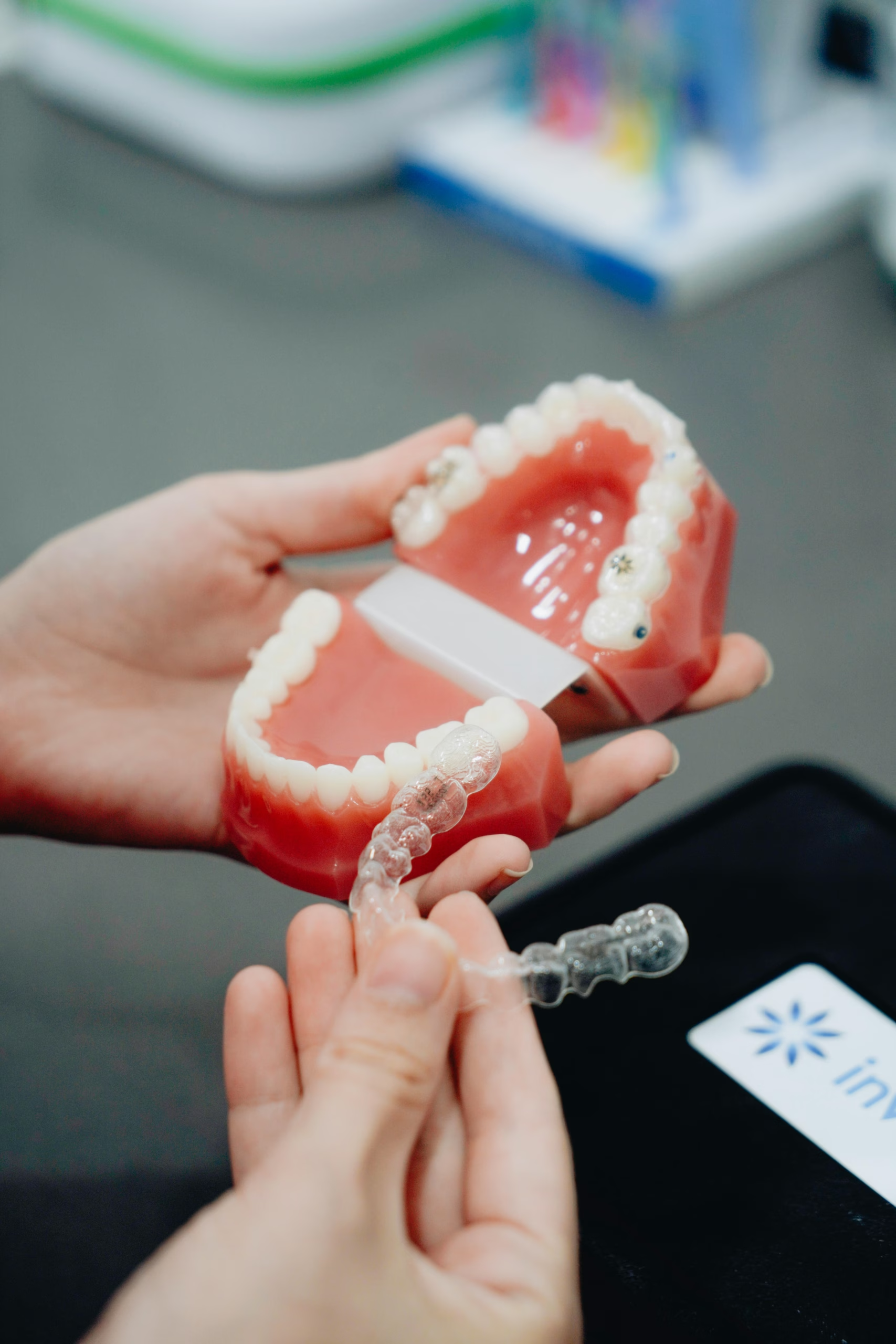How to Improve Oral Hygiene A UK Guide
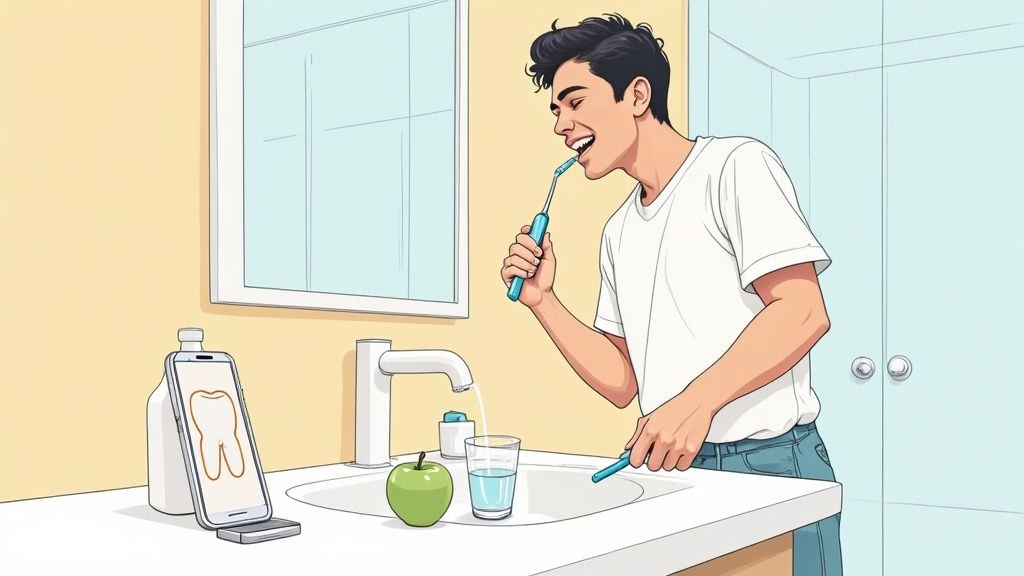
Great oral hygiene isn’t about a sudden, drastic overhaul. It’s about building small, consistent habits that add up over time to protect your health. At its heart, this comes down to mastering the fundamentals: proper brushing, daily flossing, and making sensible choices about what you eat and drink. Think of it less like a chore and more like a non-negotiable part of looking after your overall wellbeing.
Why Your Oral Hygiene Is So Much More Than Just a Nice Smile
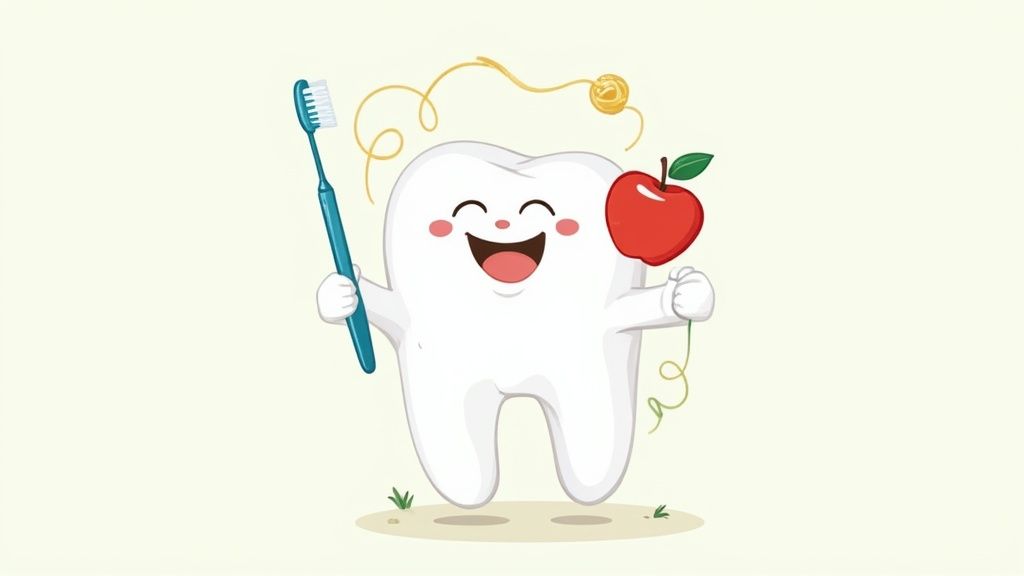
So many of us just go through the motions of brushing our teeth without really thinking about the ‘why’. But looking after your mouth is about so much more than just getting a bright smile or avoiding a filling. It’s genuinely your first line of defence for your entire body's health. Your mouth is a gateway, and if you neglect it, you’re opening the door to problems that go far beyond your teeth.
When oral care slips, harmful bacteria start to flourish, building up into that sticky film we all know as plaque. That build-up irritates your gums, causing inflammation (gingivitis). If you leave that unchecked, it can easily snowball into more serious gum disease. This isn't just a dental issue; it creates a low-grade, chronic inflammation that can put a strain on your whole system.
The Mouth-Body Connection: It’s All Linked
Getting a handle on your oral hygiene means finally appreciating just how connected your mouth is to the rest of you. The simple discipline you build into your daily routine pays off in massive ways.
- Keeping Decay at Bay: Proper, consistent brushing and flossing are what stand between your teeth and the acid-producing bacteria that cause cavities. They simply remove the fuel—plaque and food debris—that these bacteria thrive on.
- Protecting Your Gums: A solid routine is the best defence against the inflammation and infection that can lead to gum disease, and in worst-case scenarios, tooth loss.
- A Real Confidence Boost: Let's be honest, a clean and healthy mouth means fresher breath and a smile you're happy to share. That has a real, tangible impact on how you feel in social and professional situations.
Sadly, it seems many people are missing these crucial steps. It's quite shocking to learn that 75% of UK adults don't visit a dental professional regularly, which has created a noticeable dip in the nation's dental health. What’s more, 28% of dental professionals report that their patients don't seem to grasp the basics, like brushing twice a day for two minutes. It’s worth looking into the full findings on why people skip professional visits.
Remember, the goal isn't perfection from day one. It's about making small, sustainable tweaks to what you do every day. These little changes build on each other to create a powerful defence against future dental problems.
Here at Toothfairy, we're all about that preventative mindset. We've built our service to make professional guidance—for everything from a sudden emergency to cosmetic questions or affordable teeth straightening—far more accessible. By really getting to grips with the fundamentals we're about to cover, you're taking the single most important step towards a lifetime of excellent oral health.
Mastering Brushing and Flossing Techniques
Most of us brush our teeth on autopilot, a habit we’ve had since we were kids. But if you’re serious about improving your oral hygiene, it's time to move beyond just going through the motions. A few small, deliberate tweaks can make a world of difference. It’s not about brushing harder or faster, but smarter.
One of the most effective methods, and one we dentists recommend all the time, is the Modified Bass technique. It sounds complicated, but it’s actually quite simple. The key is to angle your toothbrush at 45 degrees right where your teeth meet your gums. This is the sweet spot where plaque loves to accumulate.
Instead of scrubbing aggressively back and forth, use gentle, short strokes or tiny circular motions. Focus on just two or three teeth at a time before moving on. Remember, brushing harder doesn't mean you're cleaning better. In fact, it can do more harm than good by wearing down your enamel and irritating your gums. Precision and a gentle touch are your best friends here.
Perfecting Your Brushing System
To make sure you don't miss a single spot, try thinking of your mouth in four sections: top right, top left, bottom right, and bottom left. Spend 30 seconds on each one. If you have an electric toothbrush, it probably already does this for you, pulsing every 30 seconds to tell you when it’s time to move on. This simple system is a foolproof way to give your whole mouth the attention it deserves.
Of course, your technique is only as good as your tools. A soft-bristled toothbrush is an absolute must-have. Whether you prefer a manual or an electric brush, soft bristles are non-negotiable for protecting your gums and enamel.
This straightforward infographic sums up the essential daily habits for a healthier smile.
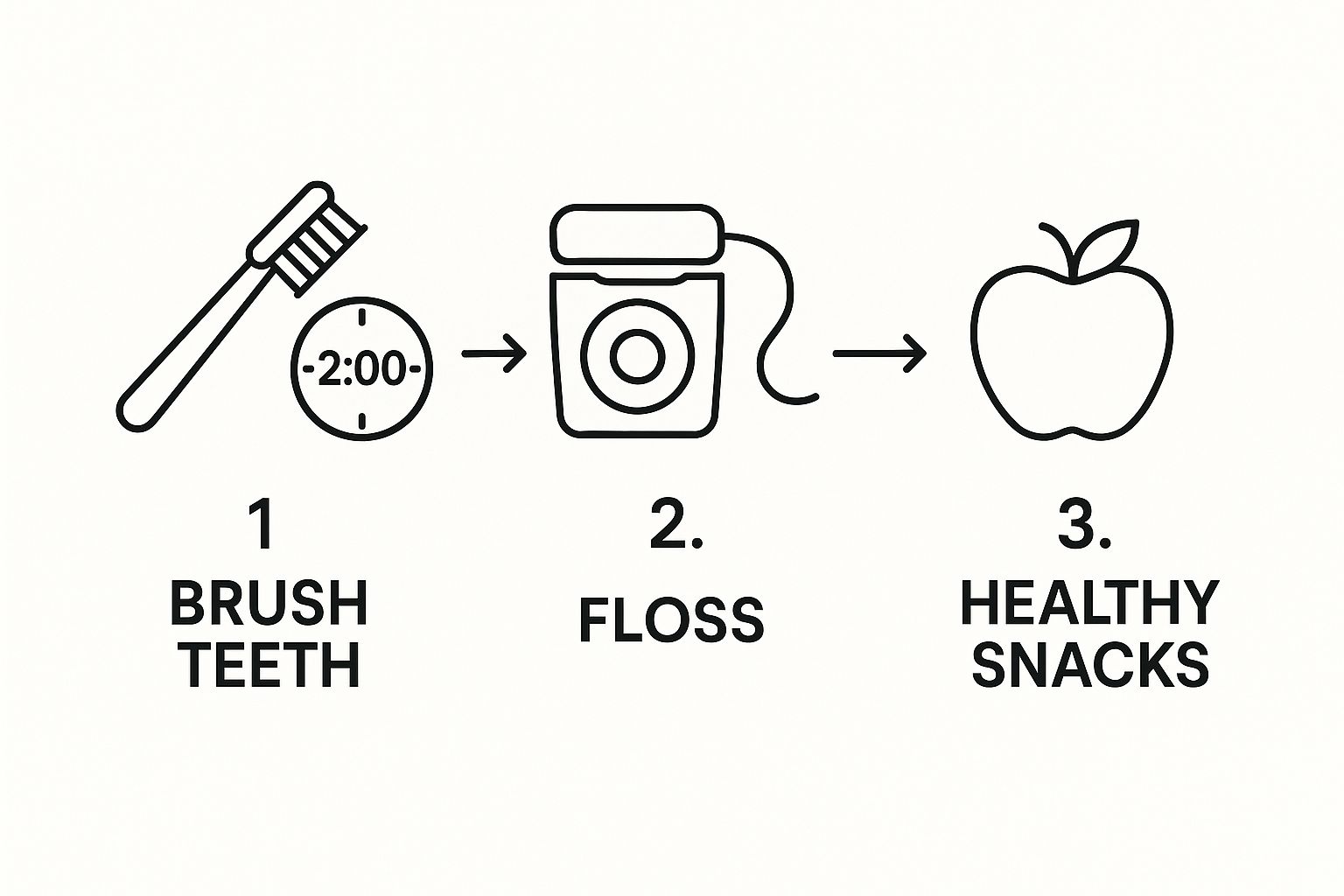
As you can see, it all comes down to a consistent routine of brushing, cleaning between your teeth, and making smart choices every day.
Getting Real About Flossing
Here's a fact that surprises many people: your toothbrush can only reach about 60% of your tooth surfaces. The other 40% is hidden between your teeth, which is a prime location for plaque to build up and cause cavities. This is why flossing isn't an optional extra—it’s essential.
Don't think of flossing as a chore. Think of it as cleaning the other half of your teeth. You wouldn't wash only one side of your dinner plates, would you?
There's no single "best" tool for the job; the best one is simply the one you'll actually use every day.
- Traditional String Floss: It’s the gold standard for a reason. Grab a piece about 18 inches long, wrap most of it around your middle fingers, and use your thumbs and index fingers to guide it. Gently slide the floss between your teeth, curving it into a 'C' shape against the side of each tooth and dipping just below the gumline.
- Water Flossers: These gadgets use a targeted stream of water to flush out plaque and food particles. They're a brilliant choice if you have braces, certain types of clear aligners, or find traditional floss a bit fiddly.
- Interdental Brushes: Think of these as tiny bottle brushes designed for the gaps between your teeth. They come in different sizes and are incredibly effective, especially if you have slightly larger spaces.
The goal is to find what feels right for you and stick with it. If you're going through any dental work, like teeth straightening with a provider like Toothfairy, keeping the spaces between your teeth clean is even more crucial for success. Our dental team is always on hand via the app to give you personalised tips and ensure your routine is perfectly suited to your needs.
How Your Diet Impacts Your Dental Health
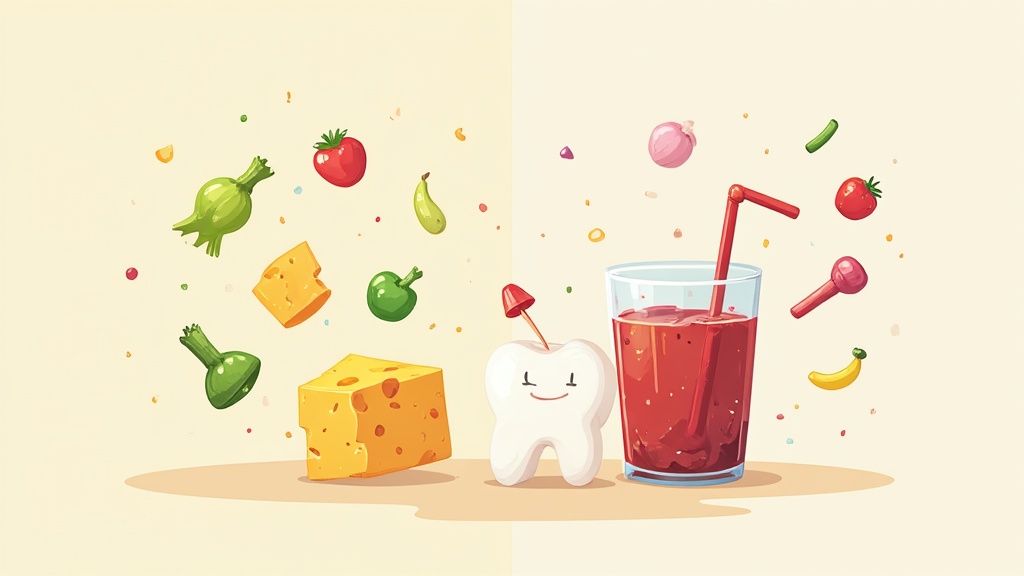
It’s easy to think that brushing and flossing are the only things that matter for a healthy smile, but what you eat has a massive, and often overlooked, impact. Your diet can either be your greatest ally or your worst enemy in the fight for good oral health. It’s not about completely overhauling your life, but about making smarter, more conscious choices every day.
We all know sugar isn't great for our teeth, but the science behind it is pretty eye-opening. When you enjoy a biscuit or a fizzy drink, the bacteria in your mouth go into overdrive, producing acids that eat away at your precious tooth enamel. This acidic assault can last for up to 20 minutes after you’ve finished that last bite or sip.
If you’re constantly snacking on sugary things, you're essentially putting your teeth under a non-stop acid attack, which is a fast track to cavities. Getting a handle on your sugar intake is a cornerstone of strong oral hygiene. For those looking for healthier alternatives, there's great advice available on choosing snack bars without added sugar.
Foods That Fight for Your Smile
The good news is that some foods genuinely work in your favour, actively protecting your teeth. Think of them as your smile’s personal security team.
By adding more of these "tooth-friendly" options into your diet, you can make a tangible difference.
- Crunchy Fruits and Veggies: Apples, carrots, and celery are brilliant. Their natural fibrous texture acts like a mini-toothbrush, scrubbing away plaque while you chew. They also get your saliva flowing, which is your body’s best defence for neutralising acid.
- Dairy Power: Cheese, milk, and plain yoghurt are packed with calcium and phosphates. These are the essential building blocks your teeth need to remineralise and stay strong.
- Leafy Greens: Don’t forget things like spinach and kale. They're loaded with calcium and folic acid, which contribute to healthy teeth and gums.
By weaving these into your meals, you’re doing more than just eating well—you’re actively fortifying your teeth against daily damage.
The simplest oral hygiene hack? Drink more water. Sipping water throughout the day, especially after meals, helps rinse away food particles and sugars, keeping your mouth's pH level balanced and less acidic.
Smart Timing Makes a Difference
Here’s a practical tip: it's not just what you eat, but when you eat it. You don’t have to swear off your favourite treats for good.
The best time to have something sweet is with a main meal. Why? Because your mouth produces more saliva when you're eating a full meal. This extra saliva helps to wash away sugars and neutralise those harmful acids before they have a chance to do serious damage. It's a far better strategy than grazing on sugary snacks throughout the day.
This kind of smart, simple adjustment can slash your risk of decay. It’s especially crucial if you’re using clear aligners for teeth straightening, as plaque can easily build up under the trays. This is where services like Toothfairy come in handy. Their app gives you direct access to dental professionals, so you can get personalised advice on diet and hygiene to ensure your journey to a straighter, healthier smile is also an affordable one.
Why Regular Dental Visits Are Essential
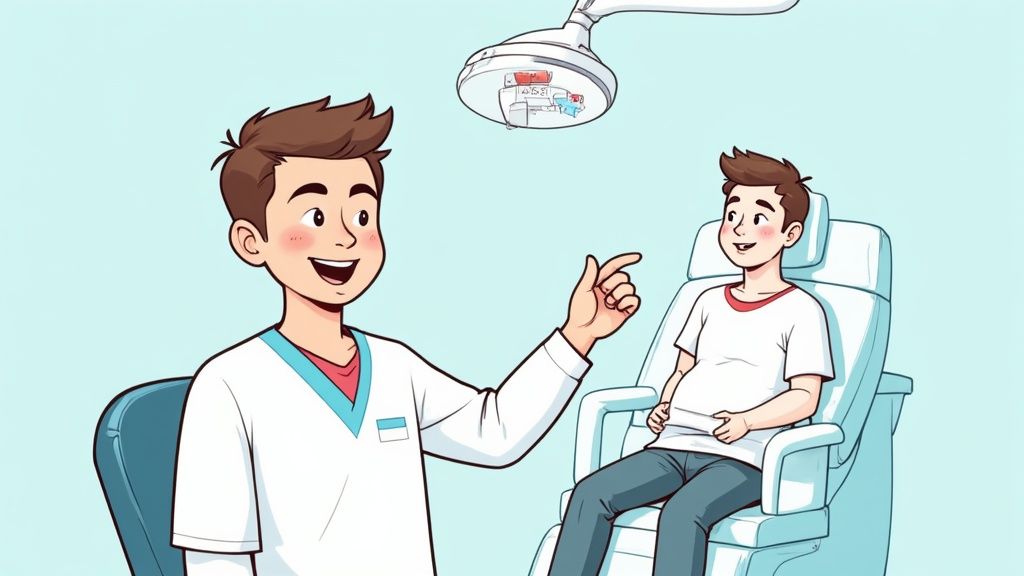
Even if your daily oral hygiene routine is flawless, it can only do so much. Think of your dentist and hygienist as your personal health coaches for your mouth; they have the specialised tools and deep expertise to elevate your care beyond what you can achieve at home. Skipping these appointments means you're missing a cornerstone of your overall health strategy.
A professional clean gets into places your toothbrush simply can't reach. While your daily brushing is fantastic at removing plaque, any that gets missed can harden into tartar, also known as calculus. Once tartar has formed, it’s impossible to brush away at home and needs a professional to remove it with special instruments.
This stubborn build-up creates a rough surface that attracts even more plaque, which can irritate your gums and dramatically increase your risk of gum disease. Your hygienist will meticulously remove this tartar and polish your teeth, leaving them feeling incredibly smooth and making it much harder for new plaque to get a foothold.
What to Expect at a Dental Check-up
A check-up is so much more than just a clean; it's a vital health screening for your entire mouth. Your dentist isn't just looking for problems you can already feel. They're trained to spot the earliest, often invisible, signs of trouble long before they cause you any pain.
This proactive approach is the secret to how to improve oral hygiene for the long haul, catching small issues before they snowball into painful or expensive procedures.
During your visit, your dentist will:
- Look for early signs of decay: They can spot weak points in your enamel and tiny cavities well before they turn into a toothache. This often means treatment is simpler and less invasive.
- Assess your gum health: They’ll check the small pockets between your teeth and gums. The depth of these pockets is a key indicator of gum health and can reveal the first signs of gum disease.
- Perform an oral cancer screen: This is a quick, painless check that’s a standard part of every exam. It’s one of the most effective ways to detect signs of oral cancer early on.
Despite these clear benefits, many people in the UK don't attend regular check-ups. Recent data reveals that over a two-year period, only about 40% of adults in England were seen by an NHS dentist. While most of these visits were for preventative care, it shows just how many people are missing out. You can read more about these UK dental care statistics from the NHS.
A dental check-up isn't a test you can pass or fail. It's a collaborative session with a health expert dedicated to helping you maintain your smile for life.
Making Professional Care More Accessible
We get it. Factors like anxiety, cost, and just finding the time can feel like huge barriers to getting dental care. If you feel anxious, it's worth looking for a practice that specifically mentions its experience with nervous patients. Reading online reviews can also give you a genuine feel for what the patient experience is like.
This is where modern solutions can really make a difference. Services like Toothfairy are designed to make professional dental care more approachable and affordable. Whether you need to manage a dental emergency from your living room, get cosmetic advice, or look into smarter ways to straighten your teeth, our app connects you directly with qualified UK dentists. It’s all about making expert care fit into your life, not the other way around.
It's no secret that technology has seeped into every corner of our lives, and our health routines are all the better for it. When it comes to looking after your teeth, a few clever gadgets and apps can make a world of difference, turning a good routine into a great one. They can help you work smarter, not just harder, and give you a much clearer picture of your oral health.
The easiest and most impactful upgrade? Ditching your manual toothbrush for an electric one. I’ve seen the difference this makes for my patients time and time again. While you can certainly do a good job with a manual brush if your technique is perfect, an electric model takes out a lot of the guesswork. Its powerful vibrations or oscillating head are fantastic at breaking up stubborn plaque far more efficiently than brushing by hand.
Think of the features on modern electric toothbrushes as your personal dental hygienist. Most come with a built-in two-minute timer, so you’ll never be tempted to cut your brushing short. They also often have a pressure sensor that buzzes or lights up if you’re scrubbing too hard – a surprisingly common habit that can really wear down your enamel and irritate your gums over the years. These little nudges are brilliant for building better habits without you even having to think about it.
Smarter Tools for a Straighter Smile
If you’ve ever thought about straightening your teeth, you’ll know the traditional route could be a long and expensive journey filled with appointments. Thankfully, technology has completely changed the landscape here, offering far more convenient and accessible options.
Clear aligners are designed to gently guide your teeth into the right position over time. This isn’t just about getting a smile you’re proud to show off; it’s also a huge win for your oral health. Straighter teeth are simply easier to clean. When teeth are crooked or crowded, they create tight, awkward gaps that are a nightmare to get a brush or floss into, making them a perfect hiding spot for plaque.
By aligning your teeth, you’re not just investing in aesthetics; you’re making a long-term investment in your oral health by simplifying your daily cleaning routine.
This is where platforms like Toothfairy really come into their own. The whole process is managed through an app that connects you with UK-based dentists, letting you handle your teeth-straightening journey right from your own home. This remote monitoring approach cuts down on costs and clinic visits, making it a seriously compelling and affordable alternative to the old way of doing things.
Personalised Dental Care in Your Pocket
Beyond brushing and straightening, smart dental apps are putting professional guidance right in the palm of your hand. Having an app like the Toothfairy app is like having a dentist on call. You can use it to track your progress, ask questions that pop into your head, and even get help with a dental emergency through a virtual consultation.
Having that direct line to a professional is priceless. Instead of saving up a minor concern for your next six-month check-up, you can get quick, personalised advice on anything from the best flossing technique to whether your diet is affecting your teeth. It’s this kind of ongoing support that keeps you motivated and ensures you’re on the right track for a truly healthy smile.
It’s interesting to see just how much has changed in dentistry. New technology isn’t just a gimmick; it’s solving real problems that people used to face with traditional dental care.
Modern vs Traditional Dental Approaches
| Dental Need | Traditional Approach | Modern Solution (e.g., Toothfairy) |
|---|---|---|
| Teeth Straightening | Multiple in-person appointments, often with higher costs associated with specific brands. | At-home impression kits and remote monitoring via an app, making it more affordable and convenient. |
| Emergency Advice | Waiting for an appointment or visiting A&E for pain relief. | Immediate virtual consultations with a qualified dentist to get advice and prescriptions. |
| Routine Questions | Holding questions until your next six-month check-up. | On-demand access to dental professionals through a secure messaging or video platform. |
As you can see, modern tools are making expert dental care more accessible and integrated into our daily lives, which is a fantastic step forward for everyone’s oral health.
Got Questions About Your Dental Routine? We've Got Answers
Even with the best intentions, it's easy to get a bit stuck when you're trying to build better oral hygiene habits. Let's face it, there's a lot of conflicting advice out there. I've heard just about every question in the book, so let's clear up a few of the most common ones I get asked.
"How Long Until I Actually See a Difference?"
This is probably the number one question I hear. People want to know their effort is paying off, and I get that. The good news is, you don't have to wait long for the initial positive signs. You'll likely notice things like fresher breath and less bleeding when you floss within just one to two weeks. Your mouth will just feel cleaner.
The deeper, more structural improvements to your gum health—the kind a dentist measures—take a bit more time. We're usually talking a few months for those changes to really take hold. The trick isn't to go hard for a week and then stop; it's all about consistency. A simple routine you do every single day will beat an intense but sporadic one every time.
"Is Expensive Toothpaste Really Worth It?"
It's a classic marketing trick, isn't it? Make you think that the more you spend, the better the results. But when it comes to toothpaste, that's rarely the case. For preventing tooth decay, the hero ingredient is fluoride, and you'll find that in almost every tube on the supermarket shelf, regardless of the price.
Sure, there are specialist toothpastes that are great for specific issues like sensitivity or whitening. If that's what you need, they can be a great help. But for everyday dental health? A standard fluoride toothpaste is all you need. Your brushing and flossing technique is what truly protects your teeth, not the fancy packaging on the tube.
"My Gums Bleed When I Floss, Should I Stop?"
This is a big one, and it's where your gut instinct can lead you astray.
"I noticed my gums bleeding when I started flossing, so I thought it was best to stop and let them heal. That makes sense, right?"
It sounds logical, but it's actually the opposite of what you should do. Bleeding is a classic sign of inflammation, or gingivitis, which is caused by plaque building up along the gumline. While it feels counterintuitive, the best thing you can do is to keep flossing, just be gentle with it.
By flossing, you're removing the very plaque that's causing the irritation in the first place. This gives your gums a chance to heal properly. Stick with it, and the bleeding should ease up and stop completely within a week or two. If it doesn't, that's your cue to book a visit with a dental professional.
Finding the Right Support for Your Smile Goals
So, what's the secret to fantastic oral hygiene? It’s not a magic product or a complex technique. It’s just showing up. The simple, unbreakable habit of brushing for two minutes, twice a day, and cleaning between your teeth once a day is the bedrock of lifelong oral health.
Of course, having an expert in your corner can make all the difference, especially when you have bigger goals in mind. If you're looking into cosmetic treatments like teeth straightening, for example, new platforms like Toothfairy offer a more modern and accessible route than some of the older, dedicated aligner brands. You get the peace of mind of being supervised by a UK dentist, with the convenience of managing it all through an app. It's a much smarter and more affordable way to work towards your goals while keeping your teeth in top condition.
Ready to take the next step towards a healthier, more confident smile? Whether you need emergency advice, cosmetic guidance, or want to explore teeth straightening, Toothfairy makes professional dental care accessible and affordable. Learn more and get started on the Toothfairy website.
Last updated on October 9, 2025

Dr. Deepak
ToothFairy Care Team.
Dr. Deepak
ToothFairy Care Team.
